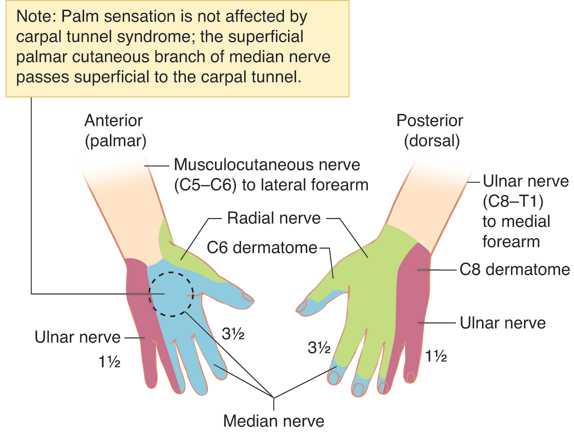If you’re preparing for the United States Medical Licensing Examination® (USMLE®) Step 1 exam, you might want to know which questions are most often missed by test-prep takers. Check out this example from Kaplan Medical, and read an expert explanation of the answer. Also check out all posts in this series.
This month’s stumper
A 24-year-old man who is a construction worker comes to the physician because of awkwardness in using his left hand. He reports that two months ago he fell on his outstretched hand and landed on the heel of the hand. Physical examination shows that the fourth and fifth fingers are extended at the metacarpophalangeal joints and flexed at the interphalangeal joints.
Which of the following additional findings is most likely to be seen on physical examination?
A. Loss of sensation on the back of the thumb.
B. Loss of sensation on the palmar side of the forefinger.
C. Wasting of the interosseous muscles.
D. Wasting of thenar eminence.
E. Wrist drop.
The correct answer is C.
Kaplan Medical explains why
Clawing of the ring and little fingers is characteristic of an ulnar nerve lesion. Ulnar nerve lesions can also produce wasting of the hypothenar eminence and interosseous muscles. The latter causes "guttering" between the extensor tendons on the back of the hand. The dorsal interosseous muscles abduct II-IV and the palmar interosseous muscles adduct digits II-V. Ulnar lesions also cause loss of sensation to the medial side of the hand (both palm and dorsal surface) and both the palmar and dorsal surfaces of the little finger and the medial half of the fourth finger.
Why the other answers are wrong
Choice A: Sensation on the back of the thumb is provided by the radial nerve.
Choice B: Sensation on the palmar side of the forefinger is provided by the median nerve.
Choice D: Wasting of the thenar eminence is associated with lesions of the median nerve.
Choice E: "Wrist drop" is associated with lesions of the radial nerve.
Tips to remember
Ulnar nerve lesions can produce:
- Clawing of the fourth and fifth digits.
- Wasting of the hypothenar eminence and dorsal interosseous muscles.
- Loss of sensation to the medial side of the hand (both palm and dorsal surface) and both the palmar and dorsal surfaces of the fifth digit and the medial half of the fourth digit.
For more prep questions on USMLE Steps 1, 2 and 3, view other posts in this series.
The AMA and Kaplan have teamed up to support you in reaching your goal of passing the USMLE® or COMLEX-USA®. If you're looking for additional resources, Kaplan provides free access to tools for pre-clinical studies, including Kaplan’s Lecture Notes series, Integrated Vignettes, Shelf Prep and more.




